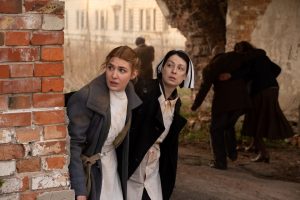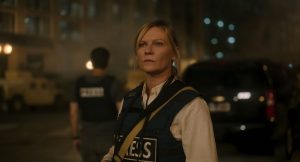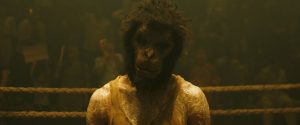Reviews include Irena’s Vow, The Beast, and Before I Change My Mind.
The Prison In Twelve Landscapes: An interview with Brett Story
November 21, 2016
by Kiva Reardon
Prisons are everywhere.
And mainstream media is saturated with representations of them: HBO’s Oz, Netflix’s Orange is the New Black, not to mention an uptick in the “true crime” (the first season of Serial, Making a Murderer, and O.J.: Made in America).

This sub-genre—and there are enough fictional features to constitute one—has, perhaps unintentionally, made prisons a matter of casual conversation. And yet for many people, prisons are never actually experienced—or even simply seen. This fact of the prison system’s visible invisibility was a starting point for director Brett Story’s interrogation of incarceration, which became The Prison in 12 Landscapes. Story’s follow-up to 2010’s Land of Destiny, Landscapes takes the structure of 12 vignettes, each relating to the trickle-down effect of the prison industrial complex in the United States: a Bronx warehouse becomes a booming business specializing in mailing goods to loved ones in the correctional system; parks are built to limit where registered sex offenders can live; California wildfires are doused by incarcerated women. Challenging the conception that prisons are removed from free society, Story’s documentary proves that the prisons’ power seeps far beyond its walls.
I talked to Story about the genesis of the project, the role of documentary work in activism, and Donald Trump.
Kiva Reardon: I’m interested in the genesis of the documentary, from the concept to how this shifted as the process of filming went on.
Brett Story: I always knew it would be a film that would entirely take place outside of the penitentiary. This idea came from a few things, one being a frustration of what constitutes “documentary cinema,” even fiction cinema, when it comes how they resign themselves to the space of the prison. They can moving works, but I don’t think they do a lot to address ideas of why we incarcerate people, or “rescue” incarnated people from the demonizing ideas we have about “people on the inside.” I also just think this [approach] gets boring—another Black man in a cage, another Indigenous person in a cage. The idea of how we can use moving image to change this [stereotype] is something I responded to.
I was interested in looking at prisons as a structure of power with a shifting history.
The other idea was that I was thinking about the problem of access: prisons are really hard to get into and they are also really far away [from urban centres]. I wanted to think about how that connected to how prisons are also bigger than they’ve ever been before. How they’ve become a huge part of American, and Canadian, life, but they’re not around for people to see and interact with. What does that mean for those of us who want to expose what’s going on inside? And how do we remain aware of what the state is up to? And if I can’t get a camera inside, what does it mean to create an imagery around what a prison is and what it’s up to in American life? At first I thought it would take place in one location on the outside. But my tendency when I’m working is to investigate questions that I don’t have the answers to. These work as prompts for me. One prompt was: where in outside seemingly free spaces can we see the prison operating? Once I started thinking this way, I found so many spaces through research and anecdotes. Very quickly on, the film started taking this prismatic approach.

This nicely segues to this idea of “landscapes” and “vignettes.” On one hand, this shows that prisons permeates all landscapes, but formally it also challenges conventional notions of “documentary.” Can you talk about your formal approach?
I was keeping an open idea about what constitutes a “landscape.” This is a bit of a truism, but I think spaces can be characters too. We understand people through the places they inhabit and have relationships in. I like to think about social life and psychology through the idea of space. For me “landscape” meant environment, which can be a physical terrain—a coal mine, a park, a warehouse where people are selling goods to send to inmates. I was thinking a lot about form in relation to content too, as I’m interested in non-linear films and films that have continuity in integrity, where the pieces feel like a part of the whole, but also allow for many things to be going on at the same time. In many ways, I take my cues from poetry and not from the novel. I wanted to create a film with many layers, so you might have an experience later in the film that could cause you to question something you had felt earlier. In order to create this complexity, which can easily become chaos, it became obvious early on that I needed some formal architecture. Here it was the modules, or vignettes.
The prison “genre” is very fixated on guilt and innocence and even access to these locked away spaces. There’s a voyeurism to it. But here you don’t touch on crime. Why?
That was the point of this whole exercise, and ties back to what I was saying about traditional prison documentaries and films, especially the ones that have progressive intentions. In focusing on people with individual stories, they end up reproducing the idea of “prison = crime,” which returns back to this idea of prisons have to be there because they solve crime. Prisons have long demonstrated this isn’t the case—they haven’t fixed crime and aren’t necessarily making people safer. I was interested in looking at prisons as a structure of power with a shifting history. In the United States, in the past forty years the prison population has exploded. I started by thinking: “this isn’t about crime, this is about the other functions of prisons, functions we don’t realize they have.” I wanted to invite people to think differently about prisons and what the consequences are.

With True/False, Hot Docs, and others, you’ve had a successful festival run. Do you see this movie as now moving into more grassroots and activist screenings?
I make political cinema. But I think what often gets categorized as “activist cinema” doesn’t always do good political work. I was taking a gamble by making this “art cinema”: a film that is formally unconventional, is slow and meditative. The risk was that it would have a marginal life and not change anything. But I think more conventional films don’t necessarily change anything either. It’s been really gratifying to have shown at so many festivals, and I just sold the doc to PBS Independent Lens, so it’s going to watched by 2 million on a major broadcaster. My abolitionist art film should be seen by lots of people! On the other hand, I also made this film out of my thinking and work and relationships to on-the-ground organizers. I’ve been now screening on a lot of campuses, and the modular structure lends itself to classrooms since you can show a scene or three scenes. And I’ve said to groups like OCAP and activist groups in the United States that they can have the film whenever they want for a fundraiser or for educational purposes.
The topic of mass incarceration has been pressing for years. With the election of Trump it feels all the more important to address.
There are so many things that can be said about that. One thing I will say is that I was on a panel right after the election and the consensus [of the panel] was that this film demonstrates that we’ve always been living in Trump’s America. Now we’re living in Trump’s America on a whole other scale. We need to think about this not as a new moment, but as a moment that has precedent, [and ask] where did it come from, and what’s giving rise to the animosity that elected Trump. For instance, the film is a lot about whiteness. After a screening, someone told me the film could have been called “White Supremacy in 12 Landscapes.” What are the structures that make white supremacy work? What’s going on in Detroit that allows a billionaire to buy up property, then round up and displace poor Black residents? The only thing I can say that doesn’t leave us in total despair is that in the wake of this election I have seen people get organized like never before. Whether that’s a mass declaration that we’ll all register as Muslims or huge donations to Planned Parenthood. People understand these are dangerous times and are rising up to organize.
Brett Story’s film will play at the Canadian Film Forum on November 23rd.



